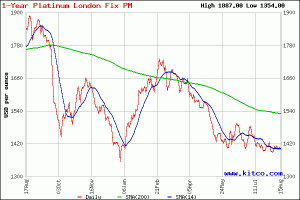 As noted in a recent post, the price of platinum has plunged almost $500 per ounce since last summer (see Platinum – Time To Buy Or Will The Bears Win?). Industrial and jewelry demand for platinum has decreased substantially due to decreased car sales and a slowing world economy. Potentially offsetting the weak demand for platinum is the increasingly violent labor strife in South African platinum mines which supply about 75% of world platinum production.
As noted in a recent post, the price of platinum has plunged almost $500 per ounce since last summer (see Platinum – Time To Buy Or Will The Bears Win?). Industrial and jewelry demand for platinum has decreased substantially due to decreased car sales and a slowing world economy. Potentially offsetting the weak demand for platinum is the increasingly violent labor strife in South African platinum mines which supply about 75% of world platinum production.
Earlier this year, Impala Platinum Holdings lost production of 120,000 ounces of platinum due to a six week strike and yesterday the world’s third largest platinum producer, Lonmim PLC, suspended most production after violence by rival labor unions left 10 people dead. According to The Wall Street Journal, “the company was only able to produce metal from previously mined material, with very little fresh mining taking place…The sharply curtailed output threatened year-end targets and crimped supplies of a metal used primarily in automobiles and jewelry.”
What was the impact on the price of platinum due to the sudden closing of a major platinum mine? Absolutely nothing as can be seen in the chart below.

Courtesy – kitco.com
The disruptions to platinum production have so far been offset by a reduction in demand and a surplus of platinum in world stockpiles according to MiningMX.
A STOCKPILE of 4.5m oz of platinum has accumulated in the global market in the past four years, and this would dampen any liveliness in the price of the valuable metal for at least the next two to three years. “The only solution is a cut in production. I would say a reduction of at least 400,000 oz per year in production capacity is called for,” said Paul Walker, head of precious-metals research at the authoritative Thomson Reuters GFMS, whose annual survey of the platinum market was released last week.
According to him, disruptions in production, like the strike at Impala Platinum in January and February, as well as the recent trend of safety stoppages – which cost about 300,000 oz in lost production – would do nothing to help the recovery in the platinum price. The accumulated global stockpile and waste metal recovered from car wrecks and the jewellery market absorb such shocks.
“I fear the accumulated 4.5m oz has become an obstacle in the market and can no longer just be shrugged off as a statistical deviation as was the case in the past two or three years. Previously we could ascribe it to factors like the downturn in 2008, but we can’t do that anymore,” he said.
The revival in the motor industry also did nothing to help the price to recover, because palladium is increasingly being used in place of platinum in diesel engines.
The stockpile of palladium was even bigger, namely 11.2m oz.
Despite the recent cutbacks in South African platinum production due to labor strife, production has actually increased by small amounts over the past years despite the growing stockpile surplus.
According to industry statistics, a price of $1,900 per ounce is necessary in order to justify new investment in platinum mines. At current prices, platinum production from existing mines is barely profitable. World platinum consumption is about 5.5 million ounces. Under the unlikely scenario that all platinum production in South Africa comes to a complete halt, existing stockpiles would quickly be depleted within a year.
Until the stockpile of surplus platinum is worked off and the auto industry recovers, platinum prices could remain under pressure. Hedge funds currently have the largest short positions in platinum ever in the futures market.
On a bullish note, all of the bearish factors affecting the price of platinum are well known and therefore discounted into the current price. The platinum market just might surprise everyone with a rally to higher prices.
Speak Your Mind